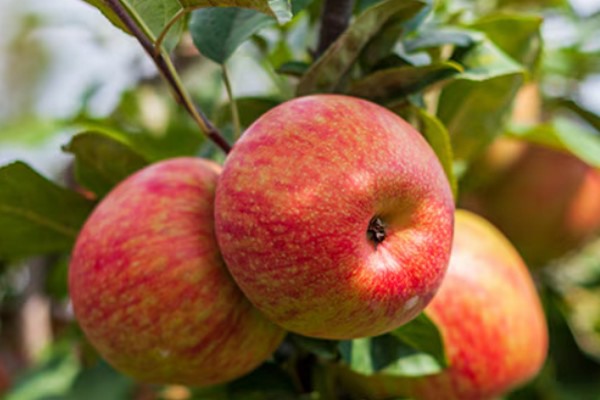What is the future of apple investment in Washington? How do consumers value apples? These are a few things Michael Swanson, Ph.D., chief agricultural economist with Wells Fargo's Agri-Food Institute, examined in his recent An Apple A Day report.
Apple's value
The report notes, "While the U.S. consumer continues to see the absolute retail price of apples rising, they also have more purchasing power thanks to higher wages and personal income."
While apple consumption has remained constant over the past few decades, that's not true of the fruit category as a whole. "When looking at the total fruit category and the fresh equivalent per pound, consumption of fruit has fallen more than two pounds per year since 2000, resulting in a reduction in fruit consumption of nearly 50 pounds per consumer across the last 23 years," notes the report. That said, most of the reduction has come in the fruit juice category given water, sports drinks, and carbonated beverages have taken market share. (Apples haven't seen this erosion in fresh fruit/juice thanks to perceived value.)
Investments in apple growing and storing
Meanwhile, apple growers have invested significantly in growing operations, producing higher yields per acre and better-tasting varieties. "These apples get picked faster and are handled more efficiently en route to the supermarket shelves by the packer and wholesaler. With intense price competition, never-ending improvement at every step of the process allows only the most dedicated to manage change to stay in the business," notes the report.

So will the investments continue? "The trend will be to limit investment due to subpar returns, at the moment," says Dr. Swanson. "However, some producers are doing much better than the industry due to strategic management and historical changes. They will continue to invest in many elements for efficiency and returns."
He also notes that the industry needs to acknowledge that the yield gains will outpace population gains. "This means that overall acreage should not grow, and in some cases, decline. The real question is: which individual apple growers will exit the industry?" he says. "This is a continuation of the trend of consolidation. The apple growers who exit should try to exit profitability to take advantage of the years' worth of effort they invested. The industry, as a whole, never adds or reduces acreage. It's always an intensely personal change."
Breaking down cost increases
Meanwhile, apples have not eluded the cost increases that the produce industry has seen, regardless of commodity.
Looking at the Honeycrisp apple for example, the report notes that prices for both the conventional and organic Honeycrisp variety have risen from the 2019 pre-COVID price shock. Some background to consider here: 2019 was a sizable crop and set a record at 42.1 metric tons per hectare. In turn, that depressed apple prices which led to the supply chain that was unsettled by COVID.
At the same time, the report also notes that "much of the cost absorbed by the consumer comes after the fruit is picked in the orchard. USDA reports that on average, approximately 80 percent of the food cost is added after the farm and ranch level. This includes food processing, packaging, wholesaling, retailing, and other costs that transform raw products into consumer-ready foods. For apples, sorting, refrigerated storage, and transportation make up the biggest cost components. These components have increased and remained elevated, increasing the price pressure on the growers as their relative share of the cost has declined."
 It concludes that even with those input costs increasing and a few years of below-average yields, the retail price of Honeycrisp apples has not increased dramatically when compared to increases over the last decade. The 2023 retail price for conventional Honeycrisp apples was 4.5 percent higher than the 2019 price, though the organic price increased by 16.6 percent in the same period.
It concludes that even with those input costs increasing and a few years of below-average yields, the retail price of Honeycrisp apples has not increased dramatically when compared to increases over the last decade. The 2023 retail price for conventional Honeycrisp apples was 4.5 percent higher than the 2019 price, though the organic price increased by 16.6 percent in the same period.
Varietal notes
Industry watchers know that the apple market is seeing a continual shuffling of varieties. "Orchard owners make multi-decade bets when planting a certain variety. They juggle yield, varietal competition, and royalty pricing, plus a host of other variables. It's not surprising to see orchard owners chase winners like Honeycrisp with more acreage, eventually capping the pricing over time."
Will the shuffle continue? Yes, says Dr. Swanson. "To be a successful new variety, the product needs to stand out to the consumer as something unique. To work, it needs to have volume and yield, along with the other marketing factors. At the end of the day, most new varieties are just another name for the same apple to the consumer," he says.
At the same time, will those new varieties appeal to new generations? "Food preferences continue to change," says Dr. Swanson. "With Gen Z representing one of the most diverse populations, the industry would benefit from asking what flavors and textures stand out to them. Polling the next generation also couldn't hurt. The industry needs to focus on the consumer of tomorrow when planting orchards that last for decades."
Purchasing power at the consumer level
The report also touches on purchasing power which compares dollars per unit to dollars earned per hour and in Honeycrisp's case, consumers can get more of this variety than in the past for an hour's wage. "Using the same 2019 to 2023 time comparison, conventional Honeycrisp apples were 18 percent more affordable and organic Honeycrisp were 6.6 percent more affordable," notes the report.
"The takeaway for the apple growers/packers in Washington state is that demand remains strong because of the great value consumers recognize with their product. It does not mean there is easy money to be made, but the growers and packers who continue adapting will see economic returns that keep the apple industry sector growing," concludes the report.
Click here for the report.
For more information:
Sarah Hatch
Wells Fargo
[email protected]
https://www.wellsfargo.com/
